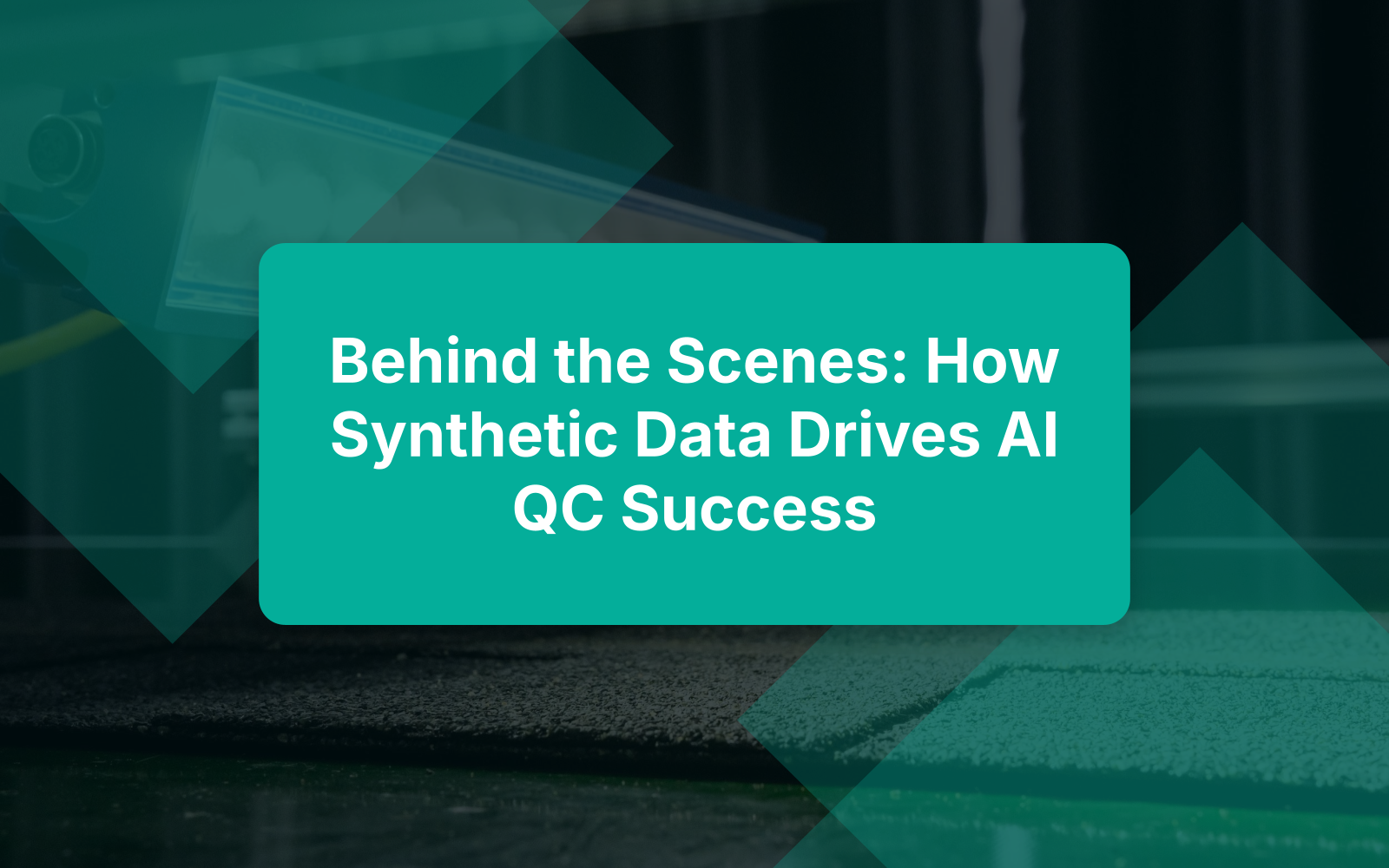Synthetic data is revolutionizing quality control processes, leading to remarkable enhancements in both efficiency and accuracy. In an age where the need for data is relentless, especially in AI-driven defect detection, the ability to generate high-quality datasets is a game changer. Zetamotion’s Spectron platform exemplifies this innovation, utilizing a proprietary data engine to create synthetic datasets efficiently. This post explores the role of synthetic data in training quality control (QC) models, its advantages, and how it’s leveraged for success in real-world applications.
What is Synthetic Data?
Synthetic data refers to information that’s been artificially generated rather than collected from real-world events. Think of it as a simulation—it mimics the statistics and features of actual data without being tied to real individuals or specific cases. This distinction is key; while real data is often messy, limited, or subject to privacy constraints, synthetic data provides a clean, flexible alternative that maintains the essential characteristics needed for analysis. Learn more about synthetic data here.
Importance of Synthetic Data in AI Model Training
In the realm of artificial intelligence, particularly for training models for tasks like quality control, having access to ample and diverse data is critical. Synthetic data fills the gaps where real data might fall short. Often, acquiring a sufficient volume of accurately labeled data poses a challenge, especially in niche areas where few samples exist. By using synthetic data, teams can create rich datasets that support robust training scenarios, ensuring AI models are well-equipped to handle variations in real-world applications.
Common Use Cases Beyond Quality Control
Beyond quality control, synthetic data finds applications in various fields. In the tech industry, it develops algorithms for self-driving cars by simulating different driving environments. In healthcare, synthetic data trains models for diagnostic tools while ensuring patient privacy. Even in retail, it aids in predicting consumer behavior without relying on sensitive transaction data. The versatility of synthetic data showcases its potential to drive innovation across numerous sectors while reducing data collection dependencies.
The Role of Synthetic Data in AI-Driven QC
Addressing Data Scarcity
In quality control (QC), the need for labeled data is persistent and often overwhelming. Traditional methods of collecting this data can be time-consuming and costly, and frequently fall short in delivering the volume and diversity required for effective AI training. Synthetic data steps in by generating artificial datasets that mimic real-world data characteristics, helping to bridge the gap caused by data scarcity. It alleviates the pressure to find enough samples and combats biases inherent in existing datasets, ensuring QC models recognize a wider range of defects.
Accelerating Model Training
Speed is crucial in today’s fast-paced production environments. Generating synthetic datasets is typically much quicker than traditional data collection methods, which require time to gather, label, and prepare. This acceleration means AI models can be trained faster, drastically reducing the time needed before deployment. Consequently, businesses can implement their quality control systems promptly and remain agile in a competitive landscape. The rapid availability of high-quality synthetic data ensures AI tools can learn effectively and adapt quickly, leading to more robust QC practices.
Key Features of Spectron’s Synthetic Data Approach
Proprietary Data Engine
Utilizes cutting-edge algorithms.
Creates diverse, custom datasets from a single input.
Simulates real-world scenarios and defects.
Produces rich, relevant data for AI model training.
Offers nuanced approaches to complex defect detection.
One-Scan Dataset Generation
Generates a full dataset from a single scan.
Reduces data collection time from weeks to minutes.
Ideal for time-sensitive industries.
Simulates conditions like lighting and angles effortlessly.
Enables faster iterations and robust quality control.
24-Hour Onboarding
Quick integration with existing QC systems.
Minimizes setup time and organizational downtime.
Allows immediate use of high-quality synthetic datasets.
Supports scalable growth in quality assurance.
Enhances AI models swiftly and efficiently.
Advantages of Using Synthetic Data in QC Models
Enhanced Accuracy
Synthetic data significantly boosts the accuracy of QC models by providing a broad array of high-quality samples. This reduces the incidence of false positives and negatives. The diversity ensures models are trained on various defect scenarios not sufficiently represented in real-world datasets, improving defect detection rates.
Cost-Effectiveness
One of the most compelling benefits of synthetic data is its cost-effectiveness. Traditional data collection methods often involve high costs in time and resources. By generating data synthetically, organizations can bypass many of these expenses, leading to more sustainable operations and enabling budget allocation toward other critical areas.
Flexibility and Adaptability
The flexibility of synthetic data generation allows teams to create datasets tailored to various defect scenarios, regardless of their rarity or complexity. This adaptability supports the continuous improvement of existing models and enables organizations to respond promptly to new challenges. By consistently integrating fresh synthetic datasets, businesses keep their QC systems sharp and relevant.
Synthetic Data Examples in Action
Manufacturing Applications
Synthetic data is vital in various manufacturing sectors. For instance, in automotive production, manufacturers use synthetic datasets to train AI models that detect defects in car body panels. By simulating manufacturing scenarios—like paint imperfections or structural flaws—models learn from a wide range of conditions without needing endless real samples. Case studies show marked improvement in defect detection rates, enhancing product quality and reducing waste.
Quality Control in Logistics
In the logistics sector, synthetic data enhances package inspection processes. Imagine an AI system that learns to identify damages in parcels during sorting. Utilizing synthetic data, this system can be trained on countless scenarios of package mishandling, from minor scratches to major crushes. For instance, a logistics company implemented synthetic datasets to improve their scanning technology’s accuracy, resulting in a 30% drop in oversight incidents, strengthening quality assurance processes.
Healthcare Innovations
Synthetic data plays a transformative role in healthcare, particularly in developing quality checks for health devices. By generating data that mimics patient scenarios, these systems test how devices respond under various conditions, ensuring safety and compliance. For example, in testing wearable heart monitors, synthetic datasets help train models to detect anomalies accurately. This enhances reliability and provides healthcare professionals with better tools to safeguard patient well-being.
Challenges and Considerations
Validity of Synthetic Data
A primary concern with synthetic data is whether it represents real-world complexities. If not reflective of actual conditions, the trained models may falter. Developers must implement robust validation methods like comparative analysis with real data, statistical testing, and scenario-based simulations to ensure synthetic datasets are reliable. Ongoing testing and refinement maintain data integrity.
Integration with Existing Systems
Integrating synthetic data with legacy systems poses challenges. Organizations often operate on setups that may not readily accommodate new data types, leading to compatibility issues or requiring significant workflow overhauls. Best practices like gradual integration or phased rollouts can overcome these hurdles. A flexible architecture supporting various data types eases transition and enhances performance, ensuring synthetic data benefits are fully realized.
Ethical Implications
Relying on synthetic data raises ethical questions about data ownership, privacy, and potential biases. Though synthetic data reduces personal data reliance, businesses must be transparent about its origins and usages. Ethical guidelines should govern the generation and application of synthetic data, ensuring compliance with legal standards and privacy respect. Organizations need frameworks to evaluate and address ethical concerns, preventing misuse and fostering trust in AI systems.
The Future of Synthetic Data in QC
Emerging Trends
The synthetic data landscape is evolving rapidly. As technology advances, we see improved algorithms and sophisticated approaches enhancing data realism and diversity. Expect increased integration with generative models like GANs (Generative Adversarial Networks), which create convincing datasets. This evolution improves synthetic data quality and expands its applicability, making it a standard tool in AI-driven QC efforts.
In addition, as machine learning intertwines more with IoT and real-time data feeds, synthetic data generation will adapt to reflect nuanced and dynamic scenarios. QC systems can become proactive, significantly reducing detection delays and increasing efficiency.
Long-Term Benefits
Businesses adopting synthetic data strategies will enhance their QC processes and position themselves for long-term success. Quick, diverse dataset generation means companies can rapidly calibrate models against emerging trends, defects, or product variations, staying competitive.
Moreover, reduced reliance on costly data collection methods leads to lower operational costs over time. This flexibility allows organizations to pivot and innovate, fostering experimentation and adaptation in a fast-paced market. As industries embrace digital transformation, synthetic data’s smart usage will be crucial for maintaining an edge, fostering innovation, and achieving operational excellence.
In summary, the future of synthetic data in quality control holds incredible promise. It equips businesses to tackle emerging challenges while paving the way for new opportunities in AI advancements. Embracing this technology is essential for organizations aiming to thrive in a data-driven world.
Conclusion
Synthetic data isn’t just a trend; it’s a fundamental pillar shaping AI-driven quality control’s future. It enables businesses to tackle challenges that once seemed insurmountable. Imagine cutting model training time while enhancing accuracy—synthetic data makes that a reality.
As industries evolve, so do quality control practices. Harnessing synthetic data improves QC processes and offers a competitive edge. This innovation paves the way for greater precision, faster deployment, and, ultimately, better products.
In a world demanding constant improvement and adaptation, embracing synthetic data can mean the difference between leading the pack or lagging behind. The future of quality control is bright, with synthetic data leading the transformation. Explore how manufacturers can get started with AI in quality control with this guide.





